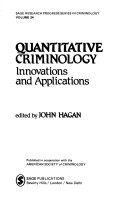SAGE Research Progress Series in Criminology
2 total works
′The SAGE Research Progress in Criminology series continues to present the important and challenging issues. Writers from a variety of disciplines and numerous countries contribute to the papers, which have a wide spread of interest and relevance to the current debate in the crime field...The seven chapters in Quantitative Criminology are excellent examples of the creative use of quantitative techniques in criminology.′ -- Police Journal, October 1983
′...the book is a welcome addition to the existing literature of ′quantitative techniques in a creative fashion′ for which the editor and the publisher deserve compliments. Indeed, the book will encourage quantitative research interest of social scientists in general and criminologists, in particular.′ -- Indian Journal of Criminology and Criminalistics, Vol 3 No 1/2, March-June 1983

